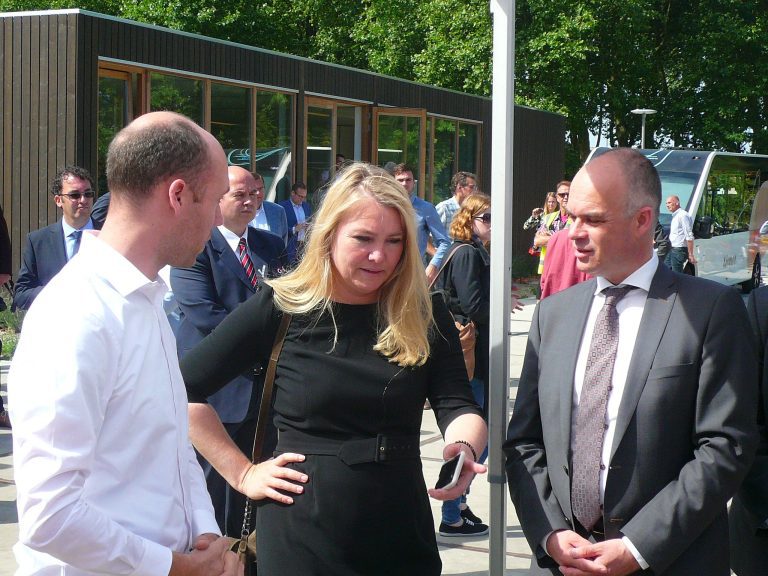The Green Village now houses the Researchlab for Automated Driving Delft (RADD). “The minister agreed that it’s time to test autonomous vehicles in practice,” said Professor Bart van Arem.
WePod approaching at the opening. (Photo: Jos Wassink)
Minister Schultz van Haegen (Infrastructure and Environment) opened the Researchlab for Automated Driving Delft (RADD) on Tuesday June 27 2017. With all the visitors ushered onto the verges, a small automatic electric bus approached slowly in the middle of the concrete track, all its lights flashing. From a safe distance, people applauded and pulled out their phones. Finally, the robot car revolution had reached Delft.
Unpredictable road users
The idea behind the RADD testing facility is to get autonomous vehicles on the road and have them interact with other traffic. Not only with regulated traffic such as other cars, but also – and perhaps especially – with unpredictable road users such as cyclists and pedestrians. The Green Village will be the starting ground for these experiments, followed by a test track on the Esplanade (between the civil engineering and electrical engineering buildings) and wherever else is deemed suitable. Researchers from RADD will use autonomous and semi-autonomous vehicles such as the WePod (a small bus), a Toyota Prius, and a Renault Twizy for their field tests.
Text continues below photo


Professor of Transport and Planning, Bart van Arem (Faculty of Civil Engineering and Geosciences, CEG), said autonomous vehicles might provide solutions for the proverbial last mile from a train station to one’s destination. Robot cars may also provide transport in thinly populated areas where other forms of public transportation are too expensive.
Car can automatically return to pick-up point
Robot vision expert, Professor Pieter Jonker (3mE Faculty), sees another option for robotic driving. “People can drive the last mile home themselves,” he said, “after which the car automatically returns to its pick-up point.”
The interaction between robot cars and pedestrians or cyclists on the street is one of the main points that the RADD research projects are focusing on. Professor Serge Hoogendoorn, who models multi-class traffic and transportation networks at the CEG Faculty, develops mathematical models which describe the sometimes erratic behaviour of pedestrians and cyclists. These models should help robot cars anticipate human behaviour.
Human reactions to robotic cars
And how do humans react to robotic cars? Behavioural scientist, Professor Marjan Hagenzieker (Faculty of CEG), found that people don’t actually know themselves. One of her students, Ana Rodríguez Palmeiro, a master’s student who graduated recently, discovered that although people say they would approach a self-driving car more carefully, or say that they will take more risk, in fact, they do not cross the road differently according to whether the car is autonomously or manually driven. Hagenzieker is planning another study with cyclists.
We can expect to see many more similar experiments and trials involving self-driving vehicles on and around the campus over the next few years.
RADD is an initiative of the TU Delft in cooperation with Delft municipality, the Province of Zuid-Holland and the Metropolitan region Rotterdam The Hague (MRDH). About twenty other municipalities, companies, and institutions have partnered with the initiative.
Do you have a question or comment about this article?
j.w.wassink@tudelft.nl

Comments are closed.